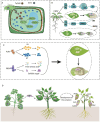Enhancing aphid resistance in horticultural crops: a breeding prospective
- PMID: 39712868
- PMCID: PMC11659385
- DOI: 10.1093/hr/uhae275
Enhancing aphid resistance in horticultural crops: a breeding prospective
Abstract
Increasing agricultural losses caused by insect infestations are a significant problem, so it is important to generate pest-resistant crop varieties to address this issue. Several reviews have examined aphid-plant interactions from an entomological perspective. However, few have specifically focused on plant resistance mechanisms to aphids and their applications in breeding for aphid resistance. In this review, we first outline the types of resistance to aphids in plants, namely antixenosis, tolerance (cell wall lignification, resistance proteins), and antibiosis, and we discuss strategies based on each of these resistance mechanisms to generate plant varieties with improved resistance. We then outline research on the complex interactions amongst plants, viruses, and aphids, and discuss how aspects of these interactions can be exploited to improve aphid resistance. A deeper understanding of the epigenetic mechanisms related to induced resistance, i.e. the phenomenon where plants become more resistant to a stress they have encountered previously, may allow for its exploitation in breeding for aphid resistance. Wild relatives of crop plants serve as important sources of resistance traits. Genes related to these traits can be introduced into cultivated crop varieties by breeding or genetic modification, and de novo domestication of wild varieties can be used to exploit multiple excellent characteristics, including aphid resistance. Finally, we discuss the use of molecular design breeding, genomic data, and gene editing to generate new aphid-resistant, high-quality crop varieties.
© The Author(s) 2024. Published by Oxford University Press on behalf of Nanjing Agricultural University.
Conflict of interest statement
The authors declare that they have no conflicts of interest.
Figures



Similar articles
-
Plant Genes Benefitting Aphids-Potential for Exploitation in Resistance Breeding.Front Plant Sci. 2019 Nov 13;10:1452. doi: 10.3389/fpls.2019.01452. eCollection 2019. Front Plant Sci. 2019. PMID: 31798609 Free PMC article. Review.
-
Plant domestication slows pest evolution.Ecol Lett. 2015 Sep;18(9):907-15. doi: 10.1111/ele.12467. Epub 2015 Jun 22. Ecol Lett. 2015. PMID: 26100381
-
Monocot crop-aphid interactions: plant resilience and aphid adaptation.Curr Opin Insect Sci. 2023 Jun;57:101038. doi: 10.1016/j.cois.2023.101038. Epub 2023 Apr 25. Curr Opin Insect Sci. 2023. PMID: 37105496 Review.
-
Identification and Genetic Characterization of Soybean Accessions Exhibiting Antibiosis and Antixenosis Resistance to Aphis glycines (Hemiptera: Aphididae).J Econ Entomol. 2019 May 22;112(3):1428-1438. doi: 10.1093/jee/toz017. J Econ Entomol. 2019. PMID: 30768167
-
Plant resistance to aphid feeding: behavioral, physiological, genetic and molecular cues regulate aphid host selection and feeding.Pest Manag Sci. 2014 Apr;70(4):528-40. doi: 10.1002/ps.3689. Epub 2014 Jan 15. Pest Manag Sci. 2014. PMID: 24282145 Review.
Cited by
-
High-throughput end-to-end aphid honeydew excretion behavior recognition method based on rapid adaptive motion-feature fusion.Front Plant Sci. 2025 Jul 7;16:1609222. doi: 10.3389/fpls.2025.1609222. eCollection 2025. Front Plant Sci. 2025. PMID: 40692669 Free PMC article.
-
Molecular analysis of the emergence of Allium cepa L. Seeds response to saline stress and treatment with essential oil of Cordia verbenacea.Sci Rep. 2025 Jul 8;15(1):24389. doi: 10.1038/s41598-025-94973-4. Sci Rep. 2025. PMID: 40629023 Free PMC article.
References
-
- Deutsch CA, Tewksbury JJ, Tigchelaar M. et al. . Increase in crop losses to insect pests in a warming climate. Science. 2018;361:916–9 - PubMed
-
- Wang J, Li Y, Wang X. et al. . Betulin, synthesized by Ppcyp716a1, is a key endogenous defensive metabolite of peach against aphids. J Agric Food Chem. 2022;70:12865–77 - PubMed
-
- De Kesel J, Conrath U, Flors V. et al. . The induced resistance lexicon: do's and don'ts. Trends Plant Sci. 2021;26:685–91 - PubMed
LinkOut - more resources
Full Text Sources

